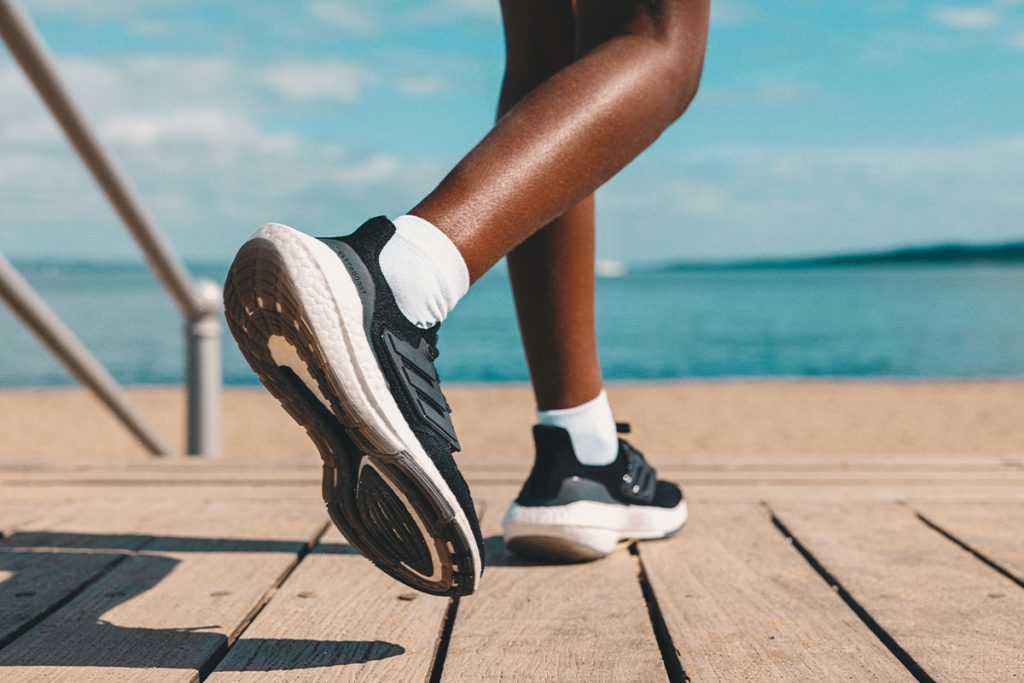Heel Strike, Toe Strike, and Posture
Walking is one of the most accessible and gentle ways to increase cardiovascular fitness. As previously covered on the adidas Runtastic blog, there’s undeniable benefits to hitting that daily step count (including weight loss). And, unlike many other sports, walking does not require special tools. However, improper walking form and technique can lead to minor injury and strain. If left untreated, these problems can impact more than an evening stroll. Here is advice for correct walking technique.
Toe Strike Or Heel Strike — Which Is Better?
Few things are as exciting in life as seeing a child walk for the first time. Noticeably, toddlers tend to favor walking on their tiptoes or on the balls of their feet. This is due to the fact that their anatomy is not yet as developed as that of an adult. According to OrthoInfo, most children begin walking on their heels around age two.
Walking with a heel strike versus a toe strike impacts the body differently. Here’s how:
- Heel striking: Heel striking describes the action of your heel making contact with the ground first, followed by the ball of your foot, in a continuous rolling motion. This method of walking or running has become natural for us over time because it requires minimal effort. Sometimes, heel striking can cause joint pain and spinal trouble. (For more information on gait actions and anatomical terminology, see this cheat sheet from the University of Oklahoma Sciences Center).
Toe striking impacts the body in very different ways.
- Toe striking: As mentioned above, this is actually the way humans instinctively move. As adults we also move this way in certain circumstances, like when we climb stairs or dance. When toe striking, your forefoot makes contact with the ground first, rolling backward and finishing with your heel on the ground. In some other mammals, like cats and raccoons, the heel actually never lands. The benefit of moving this way is that it minimizes some impact on the bones in your heels and ankles.
So, which is better?
Interestingly enough, a study by the University of Utah found that, “the heel-down posture increases the economy of walking but not the economy of running… You consume more energy when you walk on the balls of your feet or your toes than when you walk heels first.” So:
Run on your toes, walk on your heels!
As for brisk walking technique… that’s more complicated. If you find it unbearable to walk on your toes quickly for any length of time, try:
- Varying heel versus toe strike in an interval format during your walk
- Vary heel versus toe strike from one walk to the next (i.e., walk on your toes on Tuesday and heels on Thursday)
No matter what, it’s imperative that you check-in with your body after a walk on your heels OR your toes. If you’re in a lot of pain, switch to heels next time. And, vice-versa! Your body will choose its preference, and over time, with patience, you may be able to alter that choice. You might also time your walking miles. Which style results in more miles over time? That’s probably the most health-benefiting walking technique for you!
It takes time to adjust to new habits — so even if it sounds simple to change your walking technique, it won’t happen overnight. When trying to train yourself to walk in a toe strike, give yourself time and non-judgment.
Another way to learn how to toe strike – and add an interesting twist to your daily jaunt! – is to try walking backward. Walking backward also has the added benefit of strengthening the body’s posterior kinetic chain, meaning that heel-strike movement will also become safer.
Proper Walking Posture
Have you ever finished a nice long walk and then started sensing some aches and pains in your back? You may be walking in a pattern that causes irritation to your bones and muscles. Here’s a visualization of the most effective walking posture for most people. Remember: not all bodies are the same, and variations in this posture are totally acceptable, so long as the body is not in pain.
If you’re still experiencing back pain in your day-to-day life or have trouble staying upright while walking, improving core strength can help. You may have proper walking posture but still require more core strength to stabilize the hips, low back, and shoulders. That’s normal!
Now Go Walk!
Now that you know the difference between a heel strike and toe strike, get out in the world and give it a try! Track your progress on the adidas Running app, share it on social media, and tag @adidasruntastic to let us know how it goes. We can’t wait to see you.
***


